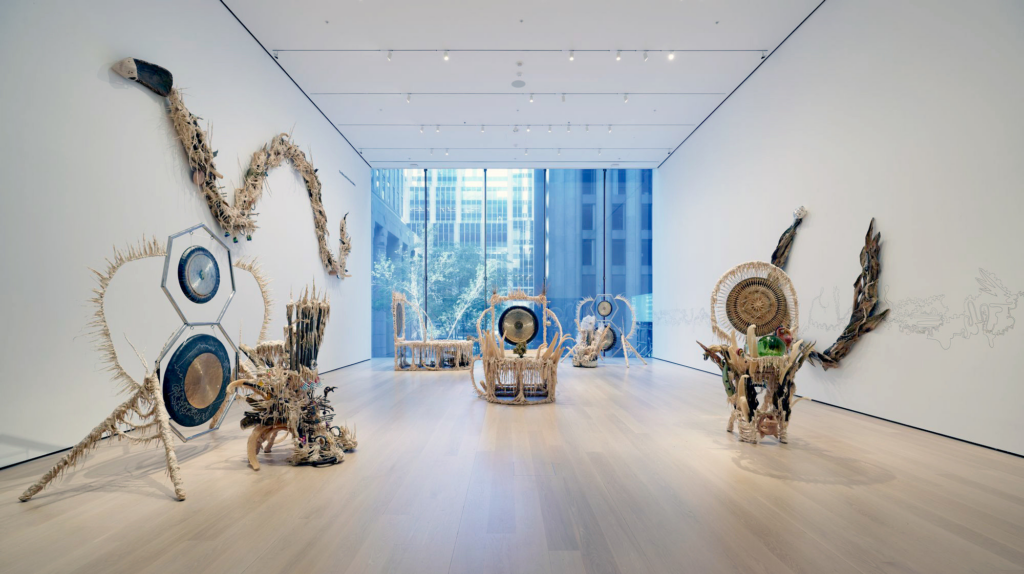
Guadalupe Maravilla is a transdisciplinary visual artist, choreographer, and healer. At the age of eight, Maravilla was part of the first wave of unaccompanied, undocumented children to arrive at the United States border in the 1980s as a result of the Salvadoran Civil War. In 2016, Maravilla became a U.S. citizen and adopted the name Guadalupe Maravilla in solidarity with his undocumented father, who uses Maravilla as his last name. As an acknowledgment to his past, Maravilla grounds his practice in the historical and contemporary contexts belonging to undocumented communities and the cancer community.
Combining pre-colonial Central American ancestry, personal mythology, and collaborative performative acts, Maravilla’s performances, objects, and drawings trace the history of his own displacement and that of others. Culling the entangled fictional and autobiographical genealogies of border crossing accounts, Maravilla nurtures collective narratives of trauma into celebrations of perseverance and humanity. Across all media, Maravilla explores how the systemic abuse of immigrants physically manifests in the body, reflecting on his own battle with cancer, which began in his gut. Maravilla’s large-scale sculptures, titled Disease Throwers, function as headdresses, instruments, and shrines through the incorporation of materials collected from sites across Central America, anatomical models, and sonic instruments such as conch shells and gongs. Described by Maravilla as “healing machines”, these Disease Throwers ultimately serve as symbols of renewal, generating therapeutic, vibrational sound.
Guadalupe Maravilla: Luz y fuerza @ MoMA

“I create new mythologies that take the form of real and fictionalized rituals based on my own lived experiences,” says Guadalupe Maravilla. Two events from the artist’s life animate his work most of all: emigrating from his native El Salvador to the United States as an unaccompanied, undocumented eight-year-old and, later, surviving cancer. From this personal history grows a multidisciplinary practice that addresses trauma, contagion, rehabilitation, and rebirth.
This gallery—whose Spanish title translates as “hope and strength”—features works inspired by Mesoamerican myths and Salvadoran traditions. The sculptures are made from natural materials and ready-made objects selected for their therapeutic, historical, symbolic, and aesthetic properties. Maravilla sees them as healing instruments he can activate—and often does, especially for people experiencing illness and other hardships. The artist is offering sound baths to various audiences as part of this presentation; for a calendar of upcoming sound baths, see below.
Guadalupe Maravilla: Luz y fuerza includes sculptures from the collection as well as new works from the artist’s studio.
Experience Guadalupe Maravilla’s Healing Sound Baths at Home
Guadalupe Maravilla: Tierra Blanca Joven @ Brooklyn Museum
Drawing on the artist’s personal story of migration, illness, and recovery, Guadalupe Maravilla: Tierra Blanca Joven centers the need for care and healing, particularly for the undocumented and cancer communities of which Guadalupe Maravilla is a part. In the 1980s, eight-year-old Maravilla fled El Salvador’s civil war and made a perilous journey through Central America to reunite with family in the United States. Following his recovery from cancer in the 2010s, the artist devoted his practice to healing through ancient methods such as sound-as-medicine (employing vibrations and frequencies of gongs to release toxins in the body). The exhibition features new sculptures, retablo paintings, tripa chuca drawings, and sound works, as well as a Healing Room, a community space for collective care designed by teen staff.
Meaning “a young white ash/earth,” Tierra Blanca Joven evokes an intergenerational experience of displacement from El Salvador: from the fifth century C.E., when the Tierra Blanca Joven volcano eruption forced the Maya people from the region by depositing a thick layer of ash over the land, to Maravilla’s own migration as a result of the 1979–92 civil war and to child refugees today, who have fled the country’s growing violence and are currently being held in U.S. detention centers. The artist’s selection of Maya works from the Museum’s collection further links Maya communal healing with displacement across time.
